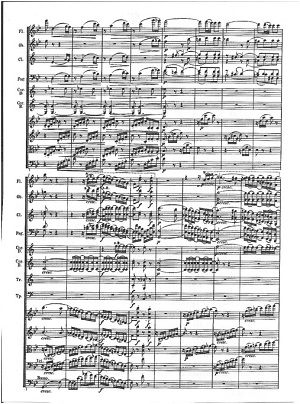This post is about how jazz and classical music each mirror a different management style in business. How Apple operates compared to McDonald’s, how Facebook functions compared to Ford. Apple and Facebook are more free form, more improvised in their management systems, like jazz. McDonald’s and Ford have very rigid managements procedures, like classical music. Let’s look more closely at classical music. When you think of Beethoven’s Ninth Symphony, who gets to call the shots?
No, if you said the conductor. No, if you said the first violin. No, if you said anybody else but the composer.
Look at the musical score below. This is just one out of 189 pages of explicit written instructions from the composer, Ludwig von Beethoven, to whoever may want to conduct the Ninth Symphony. There is no ambiguity here. No guesswork. These are directions—orders really—on how the piece is to be played. Beethoven specifies every note for every player, and tells the conductor precisely how each set of notes should be played by which musicians. Beethoven even specifies what instruments should be played (noted on the far left, just outside the score): flutes, oboes, clarinets (in B), etc. Finally, he expects the piece to be over and done with in about an hour.
The basic job of the conductor is to execute the set of directions as precisely as possible, making sure that each player is on cue, in tempo, in mood (also set by Beethoven). The conductor is judged by how well this was done.
The business analogy. This is the most common way a company runs its affairs and treats it employees. The composer is the CEO. Middle management is the conductor making sure everyone is doing their job (a Frederick Taylor-type score).
Now think of jazz for a moment. Who gets to call the shots?
No, not the composer. Often there is none. No, there is no conductor unless it is a big band. In the case of jazz, all the players get to participate. In fact, there is only music when all the players agree to the following:
- Who will get everyone started?
- What tune will be played?
- The key they will start with.
- The tempo they will start with.
- The order in which they will solo.
Now look at the score below. This is it: a key structure, a few notes, and a few chord changes. This is all that is necessary to make music the jazz way. In particular, this is all any group of musicians needs to play John Coltrane’s “Giant Steps” for as long as they agree that they want to play it. There are no time requirements. No specifications on the number of instruments. No instructions of any kind, except the discipline of the basic melody. In jazz, this is called a Fake Sheet, not an instruction manual, a fake sheet.
The only reason you can be kicked out of a jazz group is not for failure to hit a high C. Some might think you were improvising and like it. The only reason, unless the others don’t like you, is failure to pay attention. In jazz, unlike classical music, the lead instrument at the time can change the tempo and change the key at their discretion. So everyone has to pay attention, or the song goes wrong.
The business analogy. This is the management style of most start-ups. It’s the one we are using to make this website what it is. It’s the entrepreneurial model. It is the style of most research and development departments. It is the style of Apple or Facebook. While all these companies have rules and regulations, the management approach is much more improvised and generally driven by the freeform ideas from everyone. It is no surprise that these kinds of companies make the-best-companies-to-work-for lists.
While these two management models—jazz or classical music—are not cut and dried, and both provide very enjoyable music, there is something to be said for a little of both. Here is a great example. A flashmob in Sabadell, Catalonia, Spain, doing “Ode to Joy” from Beethoven’s Ninth with a jazz spirit. It a business model that could work for everyone. Note who conducts.






